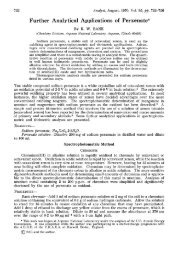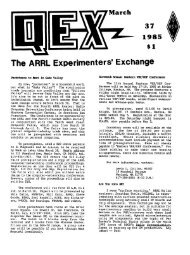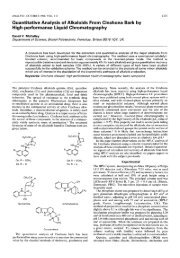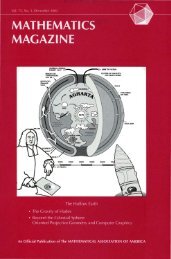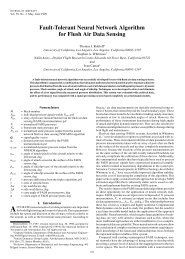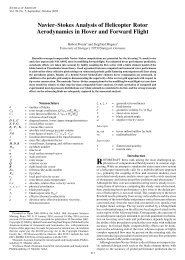pdf 6436KB Sep 25 2010 04
pdf 6436KB Sep 25 2010 04
pdf 6436KB Sep 25 2010 04
- TAGS
- 81.70.242.211
Create successful ePaper yourself
Turn your PDF publications into a flip-book with our unique Google optimized e-Paper software.
Figure 1 — W2VJN in-band notching<br />
fi lter schematic diagram.<br />
Simple point-to-point wiring is adequate.<br />
Four units were built to meet the requirements,<br />
two for 80 meters and two for 75<br />
meters.<br />
Figures 1 and 3 detail construction<br />
and performance details, and<br />
Table 2 provides a list of components.<br />
These units needed to be rugged enough<br />
to withstand the long journey via air, sea<br />
and ground to the operating positions on<br />
Ducie Island. Small aluminum boxes were<br />
used. The boards were mounted on four<br />
threaded standoffs. Type F connectors<br />
were used according to the 75 Ω system<br />
requirements.<br />
A three-element fi lter is simple enough<br />
so that formal methods are not required,<br />
and alignment can be done by alternately<br />
adjusting each tuned circuit. Watching the<br />
loss at the desired pass frequency and the<br />
null depth on a network analyzer while<br />
adjusting allows a good compromise to be<br />
found. Figure3 shows the sweep response<br />
of one of the units.<br />
As Built on Ducie Island<br />
As mentioned earlier, we did not build<br />
out the entire system at the island. With<br />
just a single receiver in the Elecraft K3 radios,<br />
we required only half of the switching<br />
matrix. We built the second parallel leg for<br />
the 45°/2<strong>25</strong>° Beverage. While this antenna<br />
performed superbly, we did not feel very<br />
strongly that we needed the second leg<br />
on the other Beverages. We also worried<br />
that adding the second leg — for example<br />
to the 15°/195° Beverage — might introduce<br />
a gap in coverage between the two<br />
Beverage arrays, especially on 80/75 with<br />
its narrower beamwidths. That gap would<br />
run right through the middle of both the<br />
US and Europe.<br />
Results<br />
Overall this system performed superbly.<br />
There’s no question that it improved signalto-noise<br />
ratio. The Beverage systems<br />
delivered superior s/n ratios compared<br />
to the transmitting antennas for these<br />
bands. Dietmar, DL3DXX, summed up the<br />
situation one evening around midnight,<br />
after he had fi nished a lengthy 160 meter<br />
operating session with Europe on a band<br />
fi lled with static: “No Beverages? Then no<br />
14 November/December 2008 NCJ<br />
Figure 2 — Notching fi lter assembled unit.<br />
Figure 3 — Typical notching fi lter measured response.<br />
QSOs,” he said.<br />
An operator could tell when sunrise occurred<br />
in the Caribbean by comparing the<br />
45° and 15° Beverages. The static level on<br />
the 45° Beverage dropped signifi cantly as<br />
sunrise moved across the Caribbean and<br />
D-layer absorption attenuated QRN from<br />
the thunderstorms in that region. The 15°<br />
Beverage still heard plenty of static from<br />
sources within its main beam.<br />
This was the fi rst DXpedition where we<br />
felt we could hear anyone calling us on<br />
Top Band. In fact, at times we could hear<br />
stations calling us much better than they<br />
could hear us.<br />
In terms of reducing QRM and dividing<br />
pileups, the Beverages’ patterns appeared<br />
to behave exactly as expected. The ARRL<br />
International DX Contest (CW) occurred<br />
early in the DXpedition, and station location<br />
is part of the contest exchange. If a W6<br />
called but was weaker on the 15° Beverage<br />
(which covered California) and louder on<br />
the 45° Beverage, we could be certain he<br />
would be in the Eastern US, not on the<br />
West Coast. The transition area where<br />
stations exhibited equal strength on these<br />
two particular Beverages was distinct and<br />
narrow — from Texas through Arkansas<br />
to Indiana and Michigan. These distinct<br />
patterns meant that the operator could<br />
focus on East Coast US stations during



